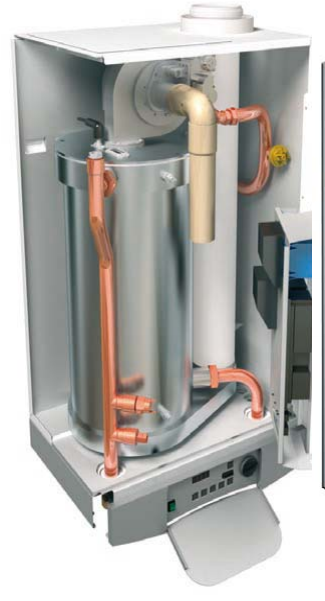Binnen- en buitenkanten warmtewisselaar
OHIM Invalidity Division 13 december 2011, ICD 8322 (A.C.V. Manufacturing NV tegen AIC S.A.)
 Gemeenschapsmodellenrecht. Na IEF 10848 (de onderkant van...), de overige modellen besproken. In de nietigheidsprocedure komt aanvrager van het Gemeenschapsmodellenrecht AIC tegen die deels succesvol aanvoerd dat de modellen nietig zijn. De modellen voor een warmtewisselaar zijn onderdeel van een complex product.
Gemeenschapsmodellenrecht. Na IEF 10848 (de onderkant van...), de overige modellen besproken. In de nietigheidsprocedure komt aanvrager van het Gemeenschapsmodellenrecht AIC tegen die deels succesvol aanvoerd dat de modellen nietig zijn. De modellen voor een warmtewisselaar zijn onderdeel van een complex product.
Gemeenschapsmodellenrecht 001137152-001 voor een binnenkant van warmtewisselaar. Het eerste model is slechts deels zichtbaar voor de eindgebruiker. Vanwege het ontbreken van dat zichtbaarheidsvereiste is er geen bescherming ex art. 4(2) CDR mogelijk. De nietigheidsafdeling citeert de Board of Appeal in ALBRIGHT France/Schaltbau: "[the design] is not sufficiently visible during normal use, apart from one side, and therefore does not meet the conditions of protection within the meaning of Article 4(2) CDR." Het model wordt nietig verklaard.
OHIM Invalidity Division 15 december 2011, ICD 8325 (A.C.V. Manufacturing NV tegen AIC S.A.)
Gemeenschapsmodelrecht 001618703-0001 voor een tweede binnenkant van warmtewisselaar. Nietigheidsprocedure. Model is geldig gedeponeerd. Onder soortgelijke motivering dat het model niet (voldoende) zichtbaar is bij toepassing door de eindgebruiker en wordt het model nietig verklaard.
OHIM Invalidity Division 13 december 2011, ICD 8335 (A.C.V. Manufacturing NV tegen AIC S.A.)
 Gemeenschapsmodelrecht 001203004-0001 voor een (buitenkant van) warmtewisselaar. Nietigheidsprocedure. Er is een prior art bewijs overlegd, echter daaruit volgt niet dat een van die bewijzen is onthuld vóór de registratiedatum. De essentiële kenmerken zijn niet enkel toe te schrijven aan de technische functie, dus bescherming ex art. 8(1) Community Design Regulation (=CDR). Model is geldig gedeponeerd.
Gemeenschapsmodelrecht 001203004-0001 voor een (buitenkant van) warmtewisselaar. Nietigheidsprocedure. Er is een prior art bewijs overlegd, echter daaruit volgt niet dat een van die bewijzen is onthuld vóór de registratiedatum. De essentiële kenmerken zijn niet enkel toe te schrijven aan de technische functie, dus bescherming ex art. 8(1) Community Design Regulation (=CDR). Model is geldig gedeponeerd.
Citaten uit ICD 8322 (binnenkant I)
(13) Considering the Community design nº 001203004-0001, registered on 19/03/2010 in OHIM and depicting heat exchangers it is demonstrated that the sieve bottom of the RCD is visible in the bottom part of the heat exchanger. Thus, the end user is in position to have a partial view of an element of the RCD while the heat exchanger insert and the heat exchanger are in motion without the necessity of opening a cover door, screwing up the boiler or disassembling the heat exchanger.
(14) The incorporation of the RCD into a heat exchanger may serve as basis for determining the visibility of the RCD during normal use of the complex product, by the end user. As far as the invisibility is concerned, the Board of Appeal has already stated that “only one side or part of a single side (of the contactor) would be visible while the other sides disappear in the complex product, which is not sufficient to meet the criterion of visibility”.
(15) In that frame, given the fact that only the bottom part of the heat exchanger insert, is visible during normal use, it is estimated that the contested RCD, incorporated into a complex product, lacks novelty and individual character within the meaning of Article 4 CDR. The RCD is not sufficiently visible during normal use, apart from one side, and therefore does not meet the conditions of protection within the meaning of Article 4(2) CDR.
Citaat uit ICD 8325:
(14) Considering the documents provided, depicting heat exchangers, it is demonstrated that the objects registered under the RCD are not visible during normal use. These heat exchangers in particular are integrated in a boiler and the end user is not in position to have view of any of the elements of the RCD while the heat exchanger and the boiler are in motion. The end user, defined as a person using the boiler into which the heat exchanger is incorporated, has to open a cover door, screw up the boiler or disassemble it in order to make the heat exchanger visible.
(15) In conclusion, it is estimated that the contested RCD, incorporated into a complex product, lacks novelty and individual character within the meaning of Article 4 CDR. The RCD is not visible during normal use, and therefore does not meet the conditions of protection within the meaning of Article 4(2) CDR.
























































































